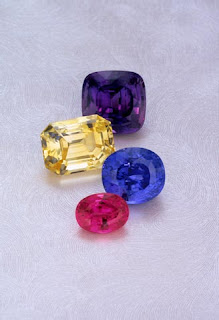.jpg)
Sapphires have been routinely heat treated for many years. The basic concept behind the treatment is that 9 times out of 10, heating the stones results in what is generally considered a more pleasing color. Some Sri Lankan sapphire occurs nearly colorless (known as "gueda") but can turn a wonderful blue color with heat treatment. Most material comes out of the ground lighter in color than what is considered most desirable.
Most desirable, of course, is often in the eye of the beholder. Personally I have always been drawn to lighter colors in sapphires as I find they sparkle more. But, either because of an individual's preference, or because of the heavy marketing of dark blue sapphires, many people want a very dark color in their sapphires.
All colors of sapphire can be heated. Much of the yellow sapphire on the market today seems to be heated. Most pink sapphire is heated. Purples are now routinely heated (although many years ago when I started selling purple sapphires most of them were not heated).
More recently sapphires have been diffusion treated. This is usually a process where the gems are heated but another element is added into the crucibles, either on purpose, or accidentally and the element is actually diffused into the stone's structure (this is all simplified quite a bit for an easier understanding of the process). Most diffusion treatments are effectively only surface treatments. This creates a problem as if you need to repolish a diffusion treated sapphire, the color will disappear. More recently however, it seems that some material has been created in which the diffusion treatment runs almost throughout the entire stone. By introducing another element into the gem, I believe this is no longer truly corundum and I won't personally sell diffusion treated stones. One of the reasons I work with so few gem dealers now is because I need to know exactly what I am getting and I only work with people I trust to know this.
I also refuse to buy my colored stones from any dealer who is not a member of the American Gem Trade Association (http://www.agta.org/). They have more information on gemstone treatment on their website if you're interested in more information. Members of their organization MUST disclose all gemstone treatments on every invoice they write. They have been the front runner in the entire topic of gemstone treatment disclosure.
A few years ago, a plethora of orange sapphire suddenly appeared on the market in quantities not seen before. Since there had been no new mines producing the material found that could account for this, the gem trade began looking a little more closely at this material. It turned out that it was almost all diffusion treated using a new process in which the treatment went most of the way through the stones. It ended up with an almost virtual halt in the trade of orange sapphires for a number of years until proper identification methods could be researched and found. Recently orange sapphire has been reappearing in the marketplace (properly disclosed) and I was fortunate enough to just purchase about 15 cts. of beautiful natural color, unheated, orange sapphire melee (stones 3.5 mm and smaller). Anyone who would like to check out some of this material come on by my store sometime and I can show you.
Next posting: More on sapphire treatments
Pictured above: Four untreated sapphires.





